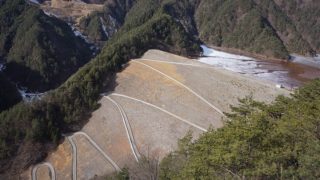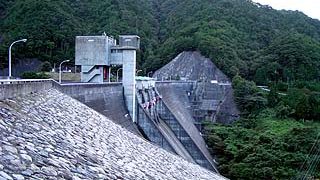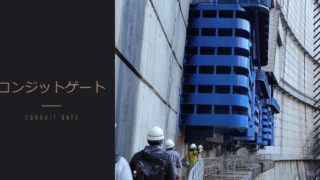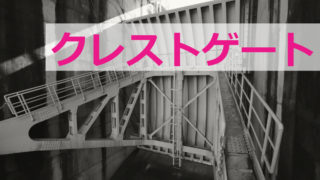"ka" column or row of the kana syllabary
 "ka" column or row of the kana syllabary
"ka" column or row of the kana syllabarytailings dam
Tailings dams are used to remove tailings (slag) generated during ore dressing and smelting in mines...
 "ka" column or row of the kana syllabary
"ka" column or row of the kana syllabarycombine dam
A combined dam is a dam that consists of both a concrete dam and a fill dam. The concrete dam is usually installed on the bank with firm ground, and the fill dam is installed on the bank with loose ground...
 "ka" column or row of the kana syllabary
"ka" column or row of the kana syllabaryconduit gate
A pipe installed for flood control or downstream discharge. Holes at the bottom of a dam are sometimes collectively called conduits. The original meaning of the word "conduit" is "conduit," and it is so called because it is installed through the embankment. A conduit is also equipped with a gate, which is called a conduit gate. Conduit gates are used as permanent flood discharges during relatively normal discharge.
 "ka" column or row of the kana syllabary
"ka" column or row of the kana syllabaryaggregate
Aggregate is the raw material used to make concrete to construct dams. Sand, crushed sand, gravel, and crushed stone are mainly used as aggregate. Aggregates are classified as fine aggregate if they pass through all 10mm sieves and 85% or more by weight through 5mm sieves, and coarse aggregate if they remain 85% or more by weight on 5mm sieves.
 "ka" column or row of the kana syllabary
"ka" column or row of the kana syllabaryflood capacity
Flood capacity refers to the capacity from the constantly full water level or flood stage limit to the surcharge water level.
 "ka" column or row of the kana syllabary
"ka" column or row of the kana syllabaryFlood discharge
A flood discharge is a gate facility used to channel water from a dam lake downstream. The inflow section, the conduit section, and the force reducing works are collectively called a flood discharge. There are two types of flood discharge: permanent flood discharge and emergency flood discharge. The so-called "dam bore," which was popular on the Internet for a while, is also called "morning glory-type flood discharge" or "morning glory-type flood discharge" because a shaft is installed in the dam lake and its mouth looks like a morning glory, but its official name is "tateko-gata-kozu-baki" (vertical shaft-type flood discharge).
 "ka" column or row of the kana syllabary
"ka" column or row of the kana syllabaryFlood control capacity
Flood control capacity is the capacity from the constantly full water level to the surcharge water level. Flood control is carried out within this capacity. In particular, during flood periods, the water level is lowered to the flood stage limit to ensure the volume of water flowing into the dam. A dam with no flood control capacity has no flood control function.
 "ka" column or row of the kana syllabary
"ka" column or row of the kana syllabaryFlood stage limit water level
Flood level limit refers to the water level established at dams for flood control purposes, and refers to the water level that is lowered below the full water level at all times during flood periods to prevent flooding.
 "ka" column or row of the kana syllabary
"ka" column or row of the kana syllabaryflood season
It refers to periods of high precipitation, such as the rainy season and typhoon season (mainly from June to October). Therefore, just before the flood season, the water level of the dam lake is lowered to prepare for flooding. Some dams have a specific time of year for flood control. For example, the Muromaki Dam in Toyama Prefecture is open from June 21 to September 30, dams directly under the Abukuma River system are open from June 11 to October 10, the Ren Dam in Mie Prefecture is open from June 16 to October 31, and the Okura Dam in Miyagi Prefecture is open from July 1 to September 30.
 "ka" column or row of the kana syllabary
"ka" column or row of the kana syllabaryflood
Flooding indicates a significant increase in the level or volume of water in a river. Factors that increase the volume of water include heavy rainfall and snowmelt. Also, a flood occurs when the flow from upstream to the dam lake is higher than usual, even if the river is not overflowing. In the case of weather forecasts, a flood is called a flood when the water level gauge of a river exceeds the warning level, which is the basis for issuing a flood warning.
 "ka" column or row of the kana syllabary
"ka" column or row of the kana syllabaryrough-coated rock
A rough stone pile is a pile from which materials necessary to construct a dam are extracted. Aggregate, the raw material for concrete, and fill material for rock-fill dams are mainly collected. The materials are collected from a mountain near the embankment, but some dams may be set up at unexpectedly distant locations. The materials are transported by cable cranes and 46-ton or other super-large dump trucks.
 "ka" column or row of the kana syllabary
"ka" column or row of the kana syllabarymomentum reducer
A momentum reducer is a structure that prevents water from flowing out of a flood discharge because the energy of the water flowing out of the discharge can be quite large, which may cause the point where the water falls to be cut off. It is literally a structure that reduces the momentum of the water. There are several types of momentum reducing structures, and they are selected according to the dam type, geology, and surrounding environment.
 "ka" column or row of the kana syllabary
"ka" column or row of the kana syllabaryPlanned high water flow rate
Planned high water flow rate indicates the river flow rate when flood control is carried out by a dam after the dam is constructed, compared to the base high water flow rate. In other words, the planned high water flow rate is the flow rate obtained by subtracting the amount of flood control by flood control facilities such as dams from the base high water flow rate. The water level at which the planned high water flow rate is displayed as a river channel cross section is called the planned high water level.
 "ka" column or row of the kana syllabary
"ka" column or row of the kana syllabaryPlanned composting capacity
The planned sediment capacity is the amount of sediment that is assumed to flow into a dam lake over a 100-year period. In Japan, where there are many mountains, more sediment than planned may flow into dam lakes due to the influence of the Median Tectonic Line and crustal movement such as earthquakes. The sediment problem is particularly serious in the Tenryu River system.
 "ka" column or row of the kana syllabary
"ka" column or row of the kana syllabarycrest gate
A crest gate is a gate installed at the crest of a dam to prevent overflow from the top of the dam, mainly used for flood control as an emergency flood discharge. The word "crest" means "top" in English, and thus a "crest gate" is a gate located at the top of a dam.
 "ka" column or row of the kana syllabary
"ka" column or row of the kana syllabarycatwalk
A catwalk is a narrow passageway installed downstream of the embankment wall, mainly in concrete dams, for work during the construction phase of the dam and for inspection after completion. They are especially seen in arch dams. As with the audit corridor, the general public is not allowed to enter the corridor, but it may be opened only for various events or when special permission is granted.
 "ka" column or row of the kana syllabary
"ka" column or row of the kana syllabarycable crane
A cable crane is a crane used in dam construction to transport materials and place concrete. Since they transport materials from the aggregate plant to the dam embankment, cables are usually stretched across the dam. Cable cranes themselves are not unique to dams, but those associated with dam construction are generally large, and sometimes only the crane foundations remain after the dam is completed.
 "ka" column or row of the kana syllabary
"ka" column or row of the kana syllabaryreverse osmosis pond
Reverse control reservoirs exist at large hydroelectric power plants where the flow increases during the day and decreases at night. A "reverse control reservoir" is a dam that is also built downstream of a power plant to store water, and by releasing a certain amount of water, the flow downstream is regulated. Depending on the size of the dam, there are dams and weirs that serve as reverse control reservoirs.
 "ka" column or row of the kana syllabary
"ka" column or row of the kana syllabarybase high-flow-rate
The base high water flow rate refers to the river flow rate (1/100 chance flow rate) at the time of a flood that is expected to occur once every 100 years (or once every 200 years) under the river conditions prior to dam construction. The term "Takamizu" is used to avoid mistakenly reading "Kozui" as "high water. The maximum value of this flow is the basis for flood control planning. When graphing, a graph called a "hydrograph" is created with time on the horizontal axis and flow rate on the vertical axis.
 "ka" column or row of the kana syllabary
"ka" column or row of the kana syllabaryFoundation Ground
The foundation ground is the ground that supports the weight of the dam. In some dams, the foundation ground is quite deep. The embankment height, which expresses the height of the dam, is the height measured from the foundation ground to the top of the embankment. Therefore, some dams may actually appear lower than the embankment height.
